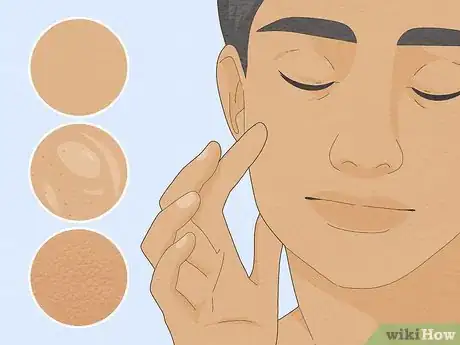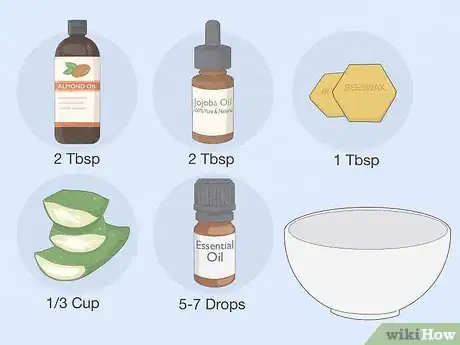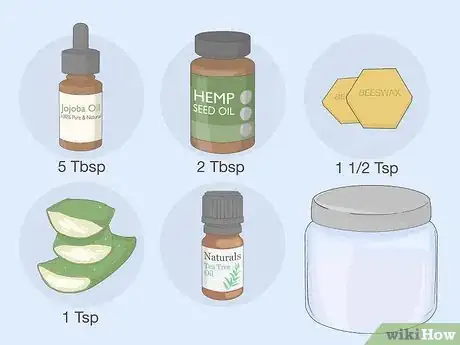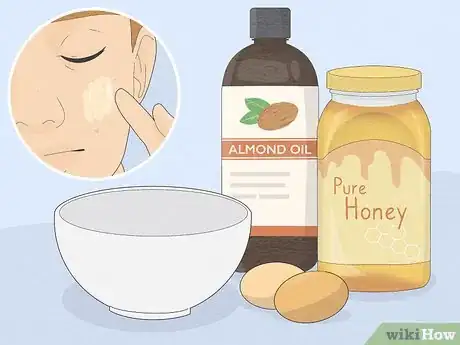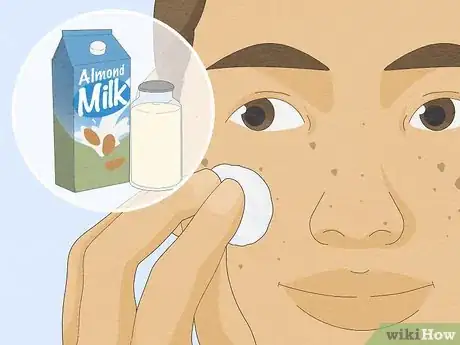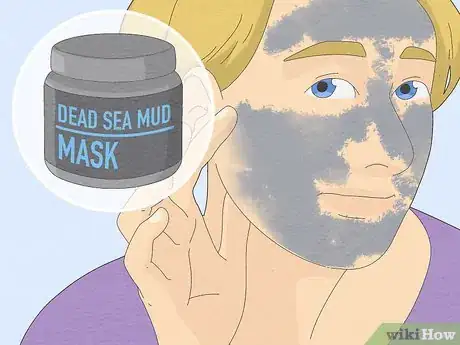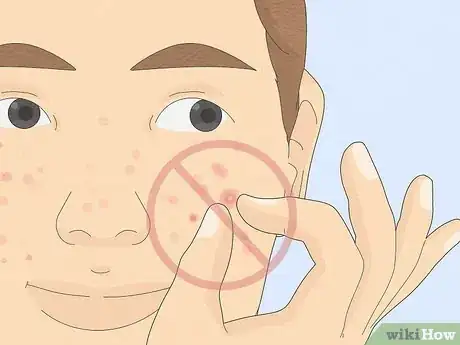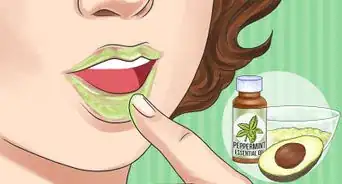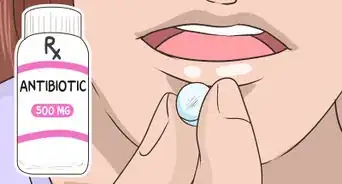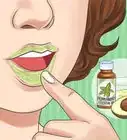This article was co-authored by Zora Degrandpre, ND. Dr. Zora Degrandpre is a Natural Health Doctor and Licensed Naturopathic Physician in Vancouver, Washington. She is a grant reviewer for the National Institutes of Health and the National Center for Complementary and Alternative Medicine. She received her ND from the National College of Natural Medicine in 2007.
There are 15 references cited in this article, which can be found at the bottom of the page.
wikiHow marks an article as reader-approved once it receives enough positive feedback. In this case, 100% of readers who voted found the article helpful, earning it our reader-approved status.
This article has been viewed 348,944 times.
Many skin care and cosmetic products currently on the market contain harmful chemicals that can damage your skin. Using homemade, natural skin care can help improve your overall complexion and give your skin a healthy glow. Along with natural remedies, it is also important to avoid factors that can cause damage to your skin. There are many ways you can make your own skin cream to help stay away from these harsh chemicals.
Steps
Making Natural Skin Cream
-
1Determine your skin type. Different skin types require different care. A dermatologist can tell you your skin type and discuss any other skin conditions you might have. Such knowledge can help you avoid foods, medications, supplements, and skin care products that could make your skin worse. In general, the types of skin are:
- Normal skin, which has little or no sensitivity, extremely small pores and a bright complexion. It is not too dry or oily.
- Combination skin, which can be dry or normal in some areas and oily in others. The oily areas usually include the nose, forehead, and chin. It can cause overly dilated pores, blackheads, and an oily sheen on certain parts of the skin.
- Oily skin, which has enlarged pores and is prone to blackheads, pimples, and other blemishes. People with oily skin can have either a dull or shiny complexion.
- Dry skin, which is characterized by less elasticity, red patches, more visible wrinkles and lines, nearly invisible pores, and a dull sheen. Certain factors such as hormonal changes, dry weather, extended hot showers, medications, ultraviolet radiation, and ingredients in skin products can make dry skin worse. This causes scaly, irritated, inflamed, or peeling skin.[1]
-
2Choose the best ingredients for your skin type. If you plan on using your own homemade cream, it is important to know what kind of ingredients will work for your skin type and what could make it worse. In general, it is important to wash your skin at least twice a day to keep it clean. This will help avoid issues caused by bacteria, fungi, and free radicals.
- People with dry skin should use cream with moisturizing agents such as aloe, cocoa butter, olive oil, or honey. These also help repair cracked skin and reduce scars. Hyaluronic acid is a naturally occurring substance in the body that heals damaged skin while locking in moisture, which can be found in some commercial skin care products. Some studies suggest that hyaluronic acid can also prevent the appearance of aging and reduce the appearance of scars and blemishes.
- If you have oily skin, opt for low-comedogenic oils, which are oils that clog your pores less. Salicylic acid is a natural cleanser derived from willow bark that neutralizes bacteria and soaks up excess oil on the skin’s surface, which helps prevent acne breakouts. Essential oils with citric acid, such as lemon oil, help control oily skin while promoting skin repair. Tea tree oil is also helpful for oily skin.
- Refreshing ingredients such as cucumber, aloe vera, or rose water alleviate inflammation and discomfort frequently experienced by people with sensitive or combination skin because of their cooling effect. Lactic acid, found in milk or yogurt, helps fight free radicals and harmful bacteria, remove dead skin cells, and gently moisturizes the skin.[2] [3]
Advertisement -
3Make a cream for dry skin. To make a skin cream for oily skin, put 1/4 cup almond oil, 2 tbsp coconut oil, 2 tbsp beeswax, 1/2 teaspoon vitamin E oil, and 1 tbsp shea butter in a glass jar. In a sauce pan, bring 3 to 4 inches of water to a simmer. Place the jar in the simmering water until the ingredients in the jar have melted completely. Then, combine the ingredients well in the jar. Move the cream into a smaller jar where you are going to keep the cream.
- Leave the cream at room temperature until the cream cools and hardens. Once it cools enough, place the lid on the jar.
- Keep the cream in a cool, dry place. The mixture can last for up to three months.
- These ingredients are good for psoriasis, eczema, and scarring on the skin. They also have anti-aging qualities as well.[4]
-
4Mix a cream for combination skin. Heat 2 tbsp of almond oil, 2 tbsp jojoba oil, and 1 tbsp beeswax in a double boiler until all the oils are melted and combined, which is about two to five minutes. Pour the mixture in a large mixing bowl and let it cool to room temperature, which is about an hour or two. While this cools, mix 1/3 cup aloe vera gel and five to seven drops of an essential oil of your choice.
- Once the mixture cools, take a hand mixture and start mixing the oils. Gradually add the aloe vera and essential oil combination while mixing. Keep adding until you get a thick consistency, about 10 minutes. You may not need to use all the aloe vera. Stop once you get the thickness you like. Move the cream to a jar.[5]
-
5Make a skin cream for oily skin. Heat 5 tbsp jojoba oil, 2 tbsp hemp seed oil, and 1 1/2 tsp beeswax in a double boiler until melted and combined. Next, remove from heat and let it cool to room temperature, when it should start to solidify. Then, using a hand mixer, whip the oils and add 1 tsp aloe vera gel and a few drops of lemon essential oil or tea tree oil. Keep whipping until it gets thick enough. Then move it to small jar.
- The jojoba oil and hemp seed oil have low comedogenic ratings, which means they are great for oily skin and won't clog your pores. The aloe vera help sooth the skin without adding oil and the lemon or tea tree oil will help remove excess oils from your skin.[6]
Using Other Natural Skin Care
-
1Try a hydrating moisturizer. In a small bowl, mix ½ an egg white with 1 teaspoon of honey and almond oil. Egg white helps with firming the skin and helps reduce fine lines and wrinkles. Almond oil gently moisturizes your skin, and honey helps seal in the moisture. Honey has also been known to reduce the appearance of blemishes and scars.
- Apply a new mixture to your face in the morning and evening after cleansing every day. Wash with lukewarm water and pat dry.[7]
-
2Use carrot. Carrots have high levels of Vitamin A, C, and B6. These are natural vitamins to help your skin stay healthy and retain its natural glow. To make your own carrot moisturizer, boil 1 chopped carrot in a saucepan for five to seven minutes, then strain. Mash the carrot in a small bowl and allow it to cool.
- Add 1 ½ tablespoon of yogurt to the mashed carrot for a cooling effect and mix until it is a smoother consistency. Store the cream in a cool, dry place in an air-tight jar. Apply twice daily after cleansing.
- To further improve your skin’s complexion, eat carrots and drink carrot juice regularly to provide your body with essential nutrients.[8]
-
3Try milk. Cleanse your face with plain, full-fat milk. The lactic acid in milk is a mild exfoliant to help remove dead cells. It also helps even out the tone of your skin and reduces scars and blemishes. You can also use almond milk, which is high in Vitamin E, a substance that moisturizes the skin and is recommended for people with dry skin.
- To use this, dip a cotton ball in a tablespoon of milk and massage it into your skin in a circular motion for at least three to five minutes. This effectively removes dirt from pores.
- If you have inflamed pimples or oily skin, mix the milk with a teaspoon of rice or gram (garbanzo) flour. Gently massage it into your skin with your fingers. Rinse off the substance with cold water and then dry.[9] [10]
-
4Make an avocado mask. Avocado has many ingredients that help stimulate the production of collagen in your face. Vitamins A and C, which are found in avocados, have antioxidant and anti-inflammatory properties. These help protect the skin from harmful free radicals. Vitamin E, also found in avocados, helps reduce scars and moisturizes the skin.
- For a natural avocado mask, peel an avocado and mash the pulp in a bowl. Apply the creamy substance to your face for 10 to 15 minutes, rinse it with cool water, then pat it dry. Apply it every day if you have dry or sensitive skin. Apply it twice a week if you have oily skin.
- To help with anti-aging, mix ½ an avocado, teaspoon of lemon juice, ½ teaspoon of plain yogurt, and 1 teaspoon of coconut oil in a small bowl. Blend until the mixture is a creamy consistency that looks smooth. This is best achieved with ripe avocados.
- Apply a small amount of this cream to your face. Keep the remainder of the cream in a cool, dry place in an air-tight container. Make sure you make this cream fresh every week, since the ingredients can go bad. Use this if you have dry and sensitive skin.[11] [12]
-
5Use a sea-silt mask. Sea silt is a type of mud that contains sea salt. This substance is found in coastal regions and includes sulfur, unsaturated fatty acids, and algae. These ingredients give the sea-silt soothing and anti-inflammatory properties. Sea-silt also helps smooth your skin's texture by removing dead skin cells as well as bacteria. It also improves the appearance of blemishes and scars.
- Sea silt can be found in numerous store bought face masks, which are generally natural. The masks generally suggest application twice a week, but also check with your dermatologist for how much you should use it based on your skin type.
- If you have dry, sensitive skin or combination skin, the sulfur and salt in the mask may cause irritation. It may also make inflamed scars worse.[13]
Taking Care of Your Skin Naturally
-
1Avoid stress. When you want to improve your skin, try to avoid stress. The hormones produced when you're stressed can cause your skin to become more sensitive to outside irritants. It also increase the production of sebum, an oil made by your skin. This oil can cause acne as well as other skin issues. Stress can also slow down healing, trigger irritations such as hives and fever blisters, and interrupt your daily routine. Avoid stress by:
- Getting regular exercise, because it can boost your mood and keep you physically active and fit. Take a moderate intensity walk for 10 minutes a day or a leisurely walk for 20 to 30 minutes at least five times a week to lift your mood.
- Get a minimum of seven to eight hours of sleep each night, since a lack of sleep can make you age faster and leave tired looking skin.
- Practice stress management techniques such as yoga, deep-breathing exercises, or meditation.[14]
-
2Have green tea. Green tea is filled with polyphenols, which are antioxidants that repair skin cells and stimulate the production of collagen in your skin. This helps give your skin a healthier glow and protect your skin from harmful free radicals and ultraviolet radiation. These properties also help reduce wrinkles and also has the benefit of decreasing stress.
- Brew green tea with warm water, which is 175 to 185°F or 80 to 85°C. Add two to three grams of loose leaf tea to the warm water for three to five minutes, then strain. You can drink this mixture two to three times each day.
- You may be able to find topical treatments that contain green tea, which can benefit your complexion by improving blemishes and other issues
- You can also use premade green tea bags instead of loose leaf.
-
3Eat a healthy diet. Eating well can improve your skin from the inside out. Eat plenty of fresh vegetables and fruit and whole grains to improve your complexion. Eat foods especially high in vitamin A, C, and E as well as zinc to reduce the severity of acne and dermatitis. Some good sources of these vitamins include:
- Sweet red peppers
- Kale
- Spinach
- Amaranth Leaves
- Turnip Greens
- Sweet Potato (Yams)
- Pumpkin
- Butternut Squash
- Mangoes
- Grapefruit
- Cantaloupe[15]
-
4Protect your skin radiation. Ultraviolet (UV) radiation from the sun can cause blemishes, sun spots, wrinkles, and other skin problems as well as increase your likelihood of skin cancer. Ways to avoid exposure to UV radiation include:
- Seeking shade as much as possible and wearing protective clothing. This includes long-sleeved shirts, wide-brimmed hats, and sunglasses, which help avoid getting wrinkles around your eyes.
- Using a broad-spectrum sunscreen. People with dark skin should wear at least SPF 15, while people with lighter skin should use at least SPF 30.[16]
-
5Touch your face as little as possible. If you have combination or oily skin, avoid touching your face as much as possible. Dirt and bacteria from your hands clog your pores, which cause blemishes. If you suffer from acne often, remove excess dirt with a gentle, oil-free facial wipe.
- Never pop or squeeze pimples. This can cause scars and spread the bad bacteria further.[17]
-
6Use skin care without paraben. Parabens are preservatives that disrupts your skin's hormonal balance and puts you at a higher risk of female centered cancers. If you have acne or eczema, these may cause skin irritation and inflammation because they are a potential allergen.
References
- ↑ http://www.webmd.com/beauty/face/whats-your-skin-type
- ↑ http://www.dermadoctor.com/blog/what-ingredients-are-best-for-oily-skin/
- ↑ https://www.beneficialbotanicals.com/facts-figures/comedogenic-rating.html
- ↑ http://www.organicauthority.com/delicious-beauty/diy-homemade-anti-aging-face-cream.html
- ↑ http://pinsandprocrastination.com/homemade-aloe-vera-face-moisturizer/
- ↑ http://manouvellemode.com/2015/02/17/homemade-face-cream-for-oily-skin/
- ↑ Nikogosian, N. (2009) Return to Beauty: Old-World Recipes for Great Radiant Skin
- ↑ Nikogosian, N. (2009) Return to Beauty: Old-World Recipes for Great Radiant Skin
- ↑ Nikogosian, N. (2009) Return to Beauty: Old-World Recipes for Great Radiant Skin
- ↑ Gabriel, J. (2012) The Acne Diet: Holistic Plan to Achieve Clear, Youthful, Acne-Free Skin with Natural Nutrition, Stress Relief and Organic Skincare
- ↑ Nikogosian, N. (2009) Return to Beauty: Old-World Recipes for Great Radiant Skin
- ↑ http://www.ncbi.nlm.nih.gov/pmc/articles/PMC3614059/
- ↑ http://www.ncbi.nlm.nih.gov/pubmed/21597673
- ↑ http://www.webmd.com/beauty/skin/the-effects-of-stress-on-your-skin
- ↑ http://www.mayoclinic.org/healthy-lifestyle/adult-health/in-depth/skin-care/art-20048237
- ↑ http://www.mayoclinic.org/healthy-lifestyle/adult-health/in-depth/skin-care/art-20048237
- ↑ https://www.aad.org/dermatology-a-to-z/diseases-and-treatments/a---d/acne/tips
- ↑ http://www.ncbi.nlm.nih.gov/pubmed/17186576
- ↑ http://www.ncbi.nlm.nih.gov/pubmed/16938376
About This Article
To make natural skin cream for normal or combination skin, heat 2 tablespoons of almond oil, 2 tablespoons of jojoba oil, and 1 tablespoon of beeswax in a double boiler for 2-5 minutes until they're fully melted and combined. As the mixture cools, in a large bowl, mix 1/3 cup of aloe vera gel and 5-7 drops of the essential oils of your choice. Then, slowly add the almond and jojoba oil mixture into the aloe vera, mixing until they're a thick consistency. For tips on making natural skin cream for dry or oily skin, read on!
